Everyday France: Lifestyle Choices That Should Guide Your Buy
Picture mornings in Le Marais or market days in Aix — then align that life with recent market data (INSEE) and practical steps to buy and steward property in France.
Imagine waking on a spring morning in France: the scent of warm croissants on a narrow Rue Vieille du Temple, a marché stall arranging sun-ripened tomatoes, and shutters opening to soft light on carved stone. That sensory rhythm — the small, deliberate pleasures of daily life — is what draws many of us here and reshapes the property brief. Yet the decision to buy is not merely aesthetic; the market has recently shifted, and where you decide to place roots will determine how that rhythm translates into value, utility and longevity. This piece pairs atmosphere with evidence so you can picture life first and then make choices that withstand markets and seasons.
Living the French Life: between marché and matinée

Parisian neighborhoods are shorthand for moods: Le Marais offers cobbled intimacy and late‑opening cafés on Rue des Rosiers, while Saint‑Germain preserves a quieter intellectual gravity beside narrow salons and bookshops. In contrast, the Côte d’Azur — from Nice’s Promenade des Anglais to quieter bays near Villefranche‑sur‑Mer — trades stone facades for pines, sea air and long summer light. Inland, Aix‑en‑Provence hums with marché mornings on Cours Mirabeau and afternoons in shaded courtyards, an architecture of worn limestone and tiled roofs that makes daily life feel composed rather than frantic.
Le Marais and central Paris: architecture, rhythm, anonymity
Le Marais is intimate at the scale of streets: 17th‑century hôtels particuliers conceal private gardens behind austere façades, and small patisseries open before dawn. Living here means accepting a compact plan — apartments with high ceilings and parquet, limited private outdoor space but incomparable access to museums, galleries and specialist shops. For buyers who prize provenance and architectural pedigree, a Marais pied‑à‑terre is a statement of stewardship more than suburban convenience.
Provencal towns and the slow life: Aix, Luberon, and market culture
In Aix‑en‑Provence and neighbouring villages, life follows seasonal cadence: marché mornings, siestas in shaded squares, and summer festivals that fill town halls with classical music. Properties here often include gardens or courtyards, space for olive trees and a view of tiled roofs — a lifestyle configured for al fresco living and slow, local consumption. For many international buyers the appeal is tangible: room to entertain, a modest restoration project and the ability to tap into established artisan networks for authentic renovation work.
- Le Marais: narrow streets, hôtels particuliers, Rue des Rosiers; Aix: Cours Mirabeau marché, Provençal ateliers; Nice: Promenade, daily beach life and year‑round markets; Bordeaux: grand 18th‑century façades, cloistered wine culture; Dordogne: restored stone maisons and verdant privacy.
Making the move: how lifestyle choices shape the property you buy

If the sensory pull of place comes first, the market context must follow. France’s national indices show returning price momentum in early 2025 after a period of stagnation: second‑hand dwelling prices rose modestly in Q1 2025, signalling renewed activity in many regional markets. That recovery is uneven—central Paris and prime coastal stretches often behave differently from provincial towns—so an area’s lifestyle virtues must be weighed against its market rhythm and liquidity.
Property types and how they accommodate life
A Parisian apartment grants immediate cultural life but asks you to relinquish private outdoor space and parking; a Provençal mas or Dordogne stone house offers land and privacy but increases maintenance and seasonal isolation. New build villas on the Côte d’Azur may offer modern conveniences and energy performance, while a restored hôtel particulier pays in provenance and architectural detail yet requires specialist craftsmen and patient budgets. Match property typology to intended use — full‑time residence, seasonal retreat, or rental — and be honest about how you will actually live there month by month.
The agency role: more than listings — cultural stewardship
- Work with agents who understand the local language of life: they should point to the morning boulangerie, the seasonal marché, reliable restorers and the quiet streets where neighbours know one another. An agent acting as steward helps translate lifestyle preferences into property briefs, sources off‑market options, and flags provenance issues or unsuitable modern interventions. Insist on agencies that can show provenance, previous restoration records and introduce local artisans — these connections preserve value and integrity.
Practical steps matter: commission provenance reports, request notarial abstracts early, and visit outside high season to judge everyday life rather than postcard moments. Parisian rarity and concentration of wealth means exceptional properties often trade with family‑to‑family discretion; elsewhere, markets are more transparent but require attention to seasonal maintenance and local rental regulations. An informed local agent is your interpreter between the lived experience and the legalities that sustain it.
Insider knowledge: what expats will not tell you up front
Expat life in France is often kinder in imagination than in reality; the adjustment is not a failure of romance but a lesson in local rhythms. Weekends that seem endlessly convivial in June can feel isolating in mid‑November when smaller cafés close early and countryside lanes are quiet. Learning to read municipal calendars, grasp the cadence of marché seasons and accept the negotiation of everyday services will shape how satisfied you are with your purchase over time.
Language, social rituals and neighbourhood membership
French social customs are deceptively formal: neighbours exchange small courtesies that build trust, and local committees can influence planning decisions and community life. Investing time in basic language, attending a marché or a municipal meeting and patronising a neighbourhood café are practical gestures that yield social capital. For long‑term owners, these gestures convert a house into a home and decrease friction with suppliers, the mairie and neighbours.
Thinking ten years ahead: stewardship, maintenance and provenance
Heritage properties reward stewardship: careful restoration with documented artisan work preserves both aesthetic and market value. Consider the recurring costs of traditional materials — lime plaster, tiled roofs, wrought iron — and ensure planned maintenance is feasible where craftsmen are scarce. Where possible, prioritise properties with recent, documented conservation work and clear notarial records; provenance reduces risk and aligns with a collector’s impulse toward legacy.
- Steps to match lifestyle with wise purchase: visit off‑season to test daily life; commission restoration reports and recent invoices; verify energy performance and insurance options; confirm local artisan availability; map nearest marchés, healthcare and schools.
- A pragmatic timetable for a considered purchase: 1) Three reconnaissance visits in different seasons; 2) Engage a trusted local agent and a notaire for preliminary due diligence; 3) Commission structural and restoration reports; 4) Negotiate with clear conditions (completion dates, restitution of documents); 5) Close with funds staged to notarial schedule and arrange ongoing property management.
France invites you to live with history: a courtyard in Aix, a narrow gallery in Le Marais, or a stone farmhouse beneath plane trees. Each offers a different contract between public life and private solace. If you pair that longing with careful, source‑based decision making — guided by agents who are custodians of local culture and records — the purchase becomes less a speculative act and more an intentional act of stewardship.
If you want to proceed, begin with a single, season‑spanning visit and bring a short list of lifestyle non‑negotiables: proximity to markets, sun exposure, and the scale of outdoor space you are prepared to maintain. Reach out to agencies who can demonstrate recent notarial precedents and introduce you to local restorers; in France, these relationships are the quiet architecture that sustains both life and value. When the place feels right in small, everyday moments, you will have found more than a property — you will have found a life.
Norwegian with years in Florence guiding clients across borders. I bridge Oslo and Tuscany, focusing on legal navigation, cultural context, and enduring craftsmanship.


